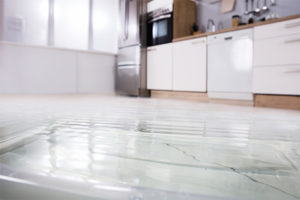Potential Water Damage From Inside Your Home
 Of course, you expect some trouble to your house when facing a historic hurricane, severe storms or epic floods. However, you are more likely to experience water damage from a more mundane source within your home. Any appliance whose pipes with a water line has the potential to develop blockages or spring leaks. Common household appliances most responsible for water damage are:
Of course, you expect some trouble to your house when facing a historic hurricane, severe storms or epic floods. However, you are more likely to experience water damage from a more mundane source within your home. Any appliance whose pipes with a water line has the potential to develop blockages or spring leaks. Common household appliances most responsible for water damage are:
Refrigerators
Refrigerators produce a lot of excess moisture, particularly when they’re cooling items in warm environments. When the door opens, warm air passes over the condenser coil creating condensation, which often pools at the bottom of your refrigerator. Most refrigerators have drain lines to siphon off this excess fluid.
The plastic or copper water supply line that feeds your ice machine can also fail; either situation will leave your kitchen a mess!
Dishwashers
Since many people run their dishwashers overnight or while everyone is out for the day, leaks have plenty of time to ruin floors and cabinetry.
Dishwashers have several opportunities to fail. Perhaps someone put too much (or the wrong type) detergent into the dispenser. A faulty float switch assembly can also malfunction. It is often due to one of the appliance’s many plumbing connections or a clogged strainer.
Washing Machines
Washing machine leaks can be disastrous; even a pinhole leak in the water supply line can flood a huge space. Common sites of failure are the inlet connections, hose connections, center post gaskets, and the pump. Consider installing an automatic shutoff valve; when water pools on the floor, the sensor detects it and closes the water valve.
Water Heaters
Water heaters corrode or degrade over time; the life expectancy of a water heater is about 8 to 12 years. Inspect and flush annually and have any faulty parts (or the entire unit) replaced at the first sign of damage. If your hot water heater or washer is located on a second story, place a pan under the appliance to catch any small spills.
Air conditioner
HVAC units manage a tremendous amount of water within the structure of your home. Attic air conditioners can cause the most damage because water can leak throughout the entire building. Install both a drain pan and a drainpipe to control the overflowing water and direct it outside. When the cooling season is about to begin, have the air conditioning system inspected and serviced by a qualified contractor. Plus, do your part by changing the air filters regularly.
Restoration 1 Of Winston-Salem
Trained in water removal and damage restoration and certified by the Institute of Inspection, Cleaning and Restoration Certification. Free inspections from fully-trained and certified restoration technicians within one hour of your call.
Water damage needs to be handled as quickly as possible, for a few reasons. First, the longer moisture is allowed to remain, the better chance there is for mold or mildew to grow. Second, prompt restoration is needed to make your home or commercial property habitable again.
The Restoration 1 process includes:
-
- We’ll ensure all areas are dried thoroughly.
-
- Our team will then remove any affected carpeting.
-
- We’ll then clean and dehumidify all surfaces to prevent the growth of mold.
- We’ll repair any damaged items.
Call (704) 504-7766 for immediate assistance with property damage. Or check out the free downloadable disaster forms and checklists at https://www.restoration1ofwinstonsalemnc.com
